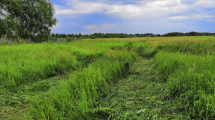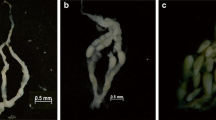Abstract
The specific features of mating females and males of different morphs collected from a population of the wasp P. dominulus in Southern Ukraine were studied. Data analysis of mating individuals in experiments indicated a random mate choice by size and assortative mating by coloration. The most actively copulating males in the experiments had light-colored mesopleuron, sternite, and fore and middle coxae. They were similar in the color pattern and size to resident males, which defend their territories in the habitat. Most P. dominulus females mated only once. In their coloration, those females represented the majority of the individuals in the population. The color variability of the foundresses was shown to change in a cyclic pattern. The possibility that such variability may result from selective or assortative mating is discussed. The color and pattern traits of P. dominulus females and males could serve as markers of their reproductive strategies and their reproductive success on the whole.
Similar content being viewed by others
References
Andersson, M., Sexual Selection (Princeton Univ. Press, 1994).
Baer, B. and Schmid-Hempel, P., “Experimental Variation in Polyandry Affects Parasite Loads and Fitness in a Bumblebee,” Nature 397, 151–154 (1999).
Beani, L. and Turillazzi, S., “An Experimental on the Relationship between Spatial Behavior and Mating Success in the Male Polistes gallicus (L.) (Hymenoptera: Vespidae),” Monit. Zool. Ital. 22, 323–330 (1988).
Beani, L. and Turillazzi, S., “Male Swarms at Landmarks and Scramble Competition Polygyny in Polistes gallicus (L.) (Hymenoptera: Vespidae),” J. Insect Behav. 3, 545–556 (1990a).
Beani, L. and Turillazzi, S., “Overlap at Landmarks by Lek-Territorial and Swarming Males of Two Sympatric Polistine Wasps (Hymenoptera Vespidae),” Ethol. Ecol. Evol. 2, 419–431 (1990b).
Beani, L. and Lorenzi, M.C., “Different Tactics of Mate Searching by Polistes biglumis bimaculatus Males (Hymenoptera: Vespidae),” Ethol. Ecol. Evol. Special Issue 2, 43–45 (1992).
Beani, L., Lorenzi, M.C., and Turillazzi, S., “Territoriality and Leks in a High Mountain Environment: Reproductive Strategy of Polistes biglumis bimaculatus Males (Hymenoptera: Vespidae),” Ethol. Ecol. Evol. 2, 297 (1992).
Boomsma, J.J., “Sex Investment Ratios in Ants: Has Female Bias been Systematically Overestimated?” Amer. Nat. 133, 517–532 (1989).
Boomsma, J.J., Baer, B., and Heinze, J., “The Evolution of Male Traits in Social Insects,” Ann. Rev. Ent. 50, 395–420 (2005).
Boomsma, J.J. and Ratnieks, F.L.W., “Paternity in Eusocial Hymenoptera,” Phil. Trans. R. Soc. London B 351, 947–975 (1996).
Boomsma, J.J. and Sundström, L., “Patterns of Paternity Skew in Formica Ants,” Behav. Ecol. Sociobiol. 42, 85–92 (1998).
Bourke, A.F.G. and Franks, N.R., Social Evolution in Ants (Princeton Univ. Press, 1995).
Brian, M.V., Social Insects: Ecology and Behavioral Biology (Chapman and Hall, 1983; Mir, Moscow, 1986) [in Russian].
Chapuisat, M., “Mating Frequency of Ant Queens with Alternative Dispersal Strategies, as Revealed by Microsatellite Analysis of Sperm,” Molec. Ecol. 7, 1097–1105 (1998).
Cole, B.J. and Wiernasz, D.C., “The Selective Advantage of Low Relatedness,” Science 285, 891–893 (1999).
Cremer, S., Lautenschleger, B., and Heinze, J., “A Transitional Stage between the Ergatoid and Winged Male Morph in the Ant Cardiocondyla obscurior,” Insectes Soc. 49, 221–228 (2002).
Dlussky, G.M., Fedoseeva, E.B., and Tompson, L.Ch., “Variability in the Ants Solenopsis richteri and S. wagneri (Hymenoptera, Formicidae): Statistical Analysis of Morphological Data,” Uspekhi Sovrem. Biol. 118(3), 283–298 (1998).
Downing, H.A., “The Function and Evolution of Exocrine Glands,” in The Social Biology of Wasps, Ed. by K.G. Ross and R.W. Matthews (Cornell Univ. Press, N.Y., 1991), pp. 540–569.
Estoup, A., Solignac, M., and Cornuet, J.-M., “Precise Assessment of the Number of Patrilines and a Genetic Relatedness in Honeybee Colonies,” Proc. R. Soc. London B 258, 1–7 (1994).
Firman, L., Norchenko, Ya., Privalova, L., and Rusina, L., “Reproductive Strategies of Polistes dominulus (Christ) Males (Hymenoptera, Vespidae) in the Black Sea Reserve,” in F.E. Falzfein Memorial Lectures: Collected Papers (Kherson, 2007), pp. 345–347 [in Ukrainian].
Fjerdingstad, E.J. and Boomsma, J.J., “Multiple Mating Increases the Sperm Stores of Atta colombica Leafcutter Ant Queens,” Behav. Ecol. Sociobiol. 42, 257–261 (1998).
Foitzik, S., Heinze, J., Oberstadt, B., and Herbers, J.M., “Mate Guarding and Alternative Reproductive Tactics in the Ant Hypoponera opacior,” Anim. Behav. 63, 597–604 (2002).
Foster, K.R. and Ratnieks, F.L.W., “Paternity, Reproduction and Conflict in Vespine Wasps: a Model System for Testing Kin Selection Predictions,” Behav. Ecol. Sociobiol. 50, 1–8 (2001).
Goodisman, M.A.D., Matthews, R.W., and Crozier, R.H., “Mating and Reproduction in the Wasp Vespula germanica, Behav. Ecol. Sociobiol. 51, 497–502 (2002).
Gritsenko, V.V., Kreslavskii, A.G., Mikheev, A.V., et al., Species Concepts and Sympatric Speciation (Mosk. Univ., Moscow, 1983) [in Russian].
Heinze, J. and Hölldobler, B., “Fighting for a Harem of Queens: Physiology of Reproduction in Cardiocondyla Male Ants,” Proc. Nat. Acad. Sci. U.S.A. 90, 8412–8414 (1993).
Helms, K.R., “Sexual Size Dimorphism and Sex Ratios in Bees and Wasps,” Amer. Nat. 143, 418–434 (1994).
Jeanne, R.L., “The Evolution of Exocrine Gland Function in Wasps,” in Natural History and Evolution of Paper Wasps, Ed. by S. Turillazzi and M.J. West-Eberhard (Oxford Univ. Press., 1996), pp. 144–160.
Kasuya, E., “Male Mating Territory in a Japanese Paper Wasp, Polistes jadwigae Dalla Torre (Hymenoptera, Vespidae),” Kontyu 49, 607–614 (1981).
Kikuta, N. and Tsuji, K., “Queen and Worker Policing in the Monogynous and Monandrous Ant, Diacamina sp.,” Behav. Ecol. Sociobiol. 46, 180–189 (1999).
Kreslavskii, A.G. and Solomatin, V.M., “Mating Structure in Natural Insect Populations,” Ekologiya, No. 2, 58–62 (1985).
Miyano, S. and Hasegawa, E., “Genetic Structure of the First Brood of Workers and Mating Frequency of Queens in a Japanese Paper Wasp, Polistes chinensis antennalis,” Ethol. Ecol. Evol. 10, 79–85 (1998).
Moritz, R.F.A., Kryger, P., Koeniger, G., et al., “High Degree of Polyandry in Apis dorsata Queens Detected by DNA Microsatellite Variability,” Behav. Ecol. Sociobiol. 37, 357–363 (1995).
Murakami, T., Higashi, S., and Windsor, D., “Mating Frequency, Colony Size, Polyethism and Sex Ratio in Fungus-Growing Ants (Attini),” Behav. Ecol. Sociobiol. 48, 276–284 (2000).
Oldroyd, B.P., Clifton, M.J., Wongsiri, S., et al., “Polyandry in the Genus Apis, Particularly Apis andreniformis,” Behav. Ecol. Sociobiol. 40, 17–26 (1997).
Palmer, K.A. and Oldroyd, B.P., “Mating Frequency in Apis florea Revisited (Hymenoptera, Apidae),” Insectes Soc. 48, 40–43 (2001).
Palmer, K.A., Oldroyd, B.P., Quezada-Euán, J.J.G., et al., “Paternity Frequency and Maternity of Males in Some Stingless Bee Species,” Molec. Ecol. 11, 2107–2113 (2002).
Pedersen, J.S. and Boomsma, J.J., “Multiple Paternity in Social Hymenoptera: Estimating the Effective Mate Number in Single-Double Mating Populations,” Molec. Ecol. 8, 577–587 (1999).
Perfil’eva, K.S., “Wing and Genital Anomalies in Sexual Ant Morphs (Hymenoptera, Formicidae) with Different Mating Strategies,” Zool. Zh. 79(11), 1305–1312 (2000).
Peters, J.M., Queller, D.C., Imperatriz-Fonseca, V.L., et al., “Mate Number, Kin Selection and Social Conflicts in Stingless Bees and Honeybees,” Proc. R. Soc. London B 266, 379–384 (1999).
Ross, K.G., “Kin Selection and the Problem of Sperm Utilization in Social Insects,” Nature 323, 798–800 (1986).
Ross, K.G., “Molecular Ecology of Social Behavior: Analyses of Breeding Systems and Genetic Structure,” Molec. Ecol. 10, 265–284 (2001).
Rusina, L.Yu., Firman, L.A., Skorokhod, O.V., and Gilev, A.V., “Coloration Variability and Principal Trends in the Pattern Development in Wasps of the Genus Polistes (Hymenoptera: Vespidae) in the Lower Dnieper Area. Communication 1. Polistes dominulus (Christ),” Izv. Kharkov. Entomol. Obshch. 12(12), 195–207 (2004).
Rusina, L.Yu., Gilev, A.V., Skorokhod, O.V., and Firman, L.A., “Seasonal Dynamics of the Phenotypic Structure of a Population of the Paper Wasp Polistes dominulus (Christ) (Hymenoptera, Vespidae),” Entomol. Obozr. 85(1), 39–48 (2006) [Entomol. Review 86 (2), 168–175 (2006)].
Rusina, L.Yu., Gilev, A.V., Skorokhod, O.V., et al., “Coloration of the Wasp Polistes dominulus in Relation with Its Spatial and Ethological Population Structure in the Lower Dnieper Area,” Uspekhi Sovrem. Biol. 127(2), 157–165 (2007a).
Rusina, L.Yu., Rusin, I.Yu., Starr, C.K., et al., “Modes of Colony Foundation by Females of Different Morphotypes in the Paper Wasps (Hymenoptera, Vespidae, Polistes Latr.), Entomol. Obozr. 86(4), 750–772 (2007b) [Entomol. Review 87 (9), 1155–1173 (2007)].
Schmid-Hempel, P. and Crozier, R.H., “Polyandry versus Polygyny versus Parasites,” Phil. Trans. R. Soc. London 354, 507–515 (1999).
Seppä, P., Queller, D.C., and Strassmann, J.E., “Reproduction in Foundress Associations of the Social Wasp, Polistes carolina: Conventions, Competition, and Skew,” Behav. Ecol. 13, 531–542 (2002).
Sergievskii, S.O., “Polymorphism as a Universal Adaptive Population Strategy,” Trudy Zool. Inst. Akad. Nauk SSSR 160, 41–58 (1987).
Strassmann, J.E., “The Rarity of Multiple Mating by Females in the Social Hymenoptera,” Insectes Soc. 48, 1–13 (2001).
Strassmann, J.E., Nguyen, J.S., Arévalo, E., et al., “Worker Interests and Male Production in Polistes gallicus, a Mediterranean Social Wasp,” J. Evol. Biol. 16, 254–259 (2003).
Thornhill, R. and Alcock, J., The Evolution of Insect Mating Systems (Harvard Univ. Press, Cambridge, MA, 1983).
Timofeev-Ressovsky, N.V., Yablokov, A.V., and Glotov, N.V., The Concept of a Population (Nauka, Moscow, 1973) [in Russian].
Tsuchida, K., “Genetic Relatedness and the Breeding Structure of the Japanese Paper Wasp, Polistes jadwigae,” Ethol. Ecol. Evol. 6, 237–242 (1994).
Tsuji, K. and Yamauchi, K., “Colony Level Sex Allocation in a Polygynous and Polydomous Ant,” Behav. Ecol. Sociobiol. 34, 157–167 (1994).
Turillazzi, S., “Patrolling Behavior in Males of Parischnogaster nigricans serrei (Du Buysson) and P. mellyi (Saussure) (Hymenoptera, Stenogastrinae),” Accad. Naz. Lincei Rendic. Classe Sci. Fis. Mat. Nat. 72, 153–157 (1982).
Turillazzi, S., “Extranidal Behavior of Parischnogaster nigricans serrei (Du Buysson) (Hymenoptera, Stenogastrinae),” Z. Tierpsychol. 63, 27–36 (1983).
Turillazzi, S., “The Stenogastrinae,” in The Social Biology of Wasps, Ed. by Ross, K.G. and Matthews, R.W. (Cornell Univ. Press, N.Y., 1991), pp. 74–98.
Villesen, P., Gertsch, P.J., Frydenberg, J., et al., “Evolutionary Transition from Single to Multiple Mating in Fungus-Growing Ants,” Molec. Ecol. 8, 1819–1825 (1999).
Yamauchi, K., Oguchi, S., Nakamura, Y., et al., “Mating Behavior of Dimorphic Reproductives of the Ponerine Ant Hypoponera nubatama,” Insectes Soc. 48, 83–87 (2001).
Author information
Authors and Affiliations
Additional information
Original Russian Text © L.A. Firman, L.Yu. Rusina, 2009, published in Entomologicheskoe Obozrenie, 2009, Vol. 88, No. 2, pp. 292–306.
Rights and permissions
About this article
Cite this article
Firman, L.A., Rusina, L.Y. Mating system in a population of the wasp Polistes dominulus (Christ) (Hymenoptera, Vespidae). Entmol. Rev. 89, 529–541 (2009). https://doi.org/10.1134/S0013873809050029
Received:
Published:
Issue Date:
DOI: https://doi.org/10.1134/S0013873809050029




